
Concept explainers
(a)
Interpretation:
The hybridization of each non-hydrogen atom in Octocrylene is to be determined.
Concept introduction:
A hybrid atomic orbital is a cross between two or more pure AOs from the valence shell of a single atom. Typically
Answer to Problem 3.54P
Atoms shown in blue color are
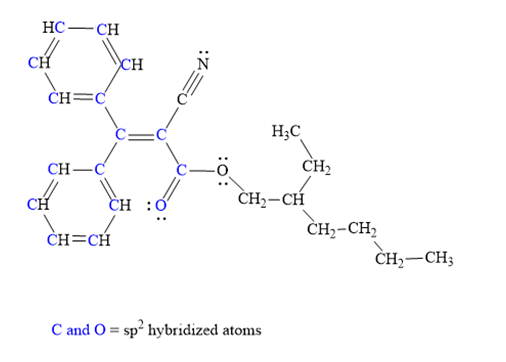
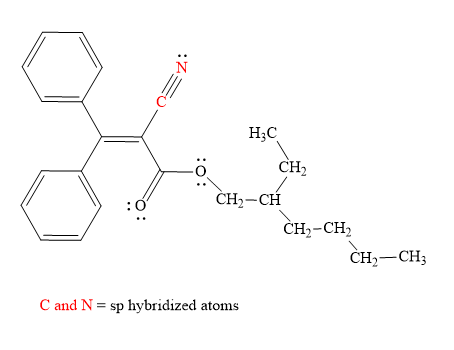
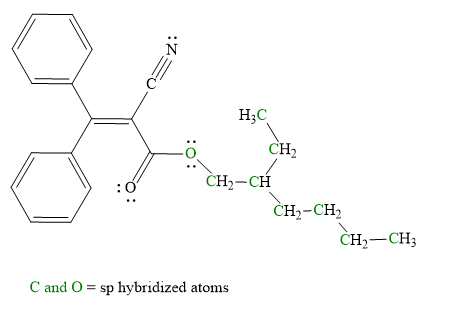
Explanation of Solution
The given structure for Octocrylene is:
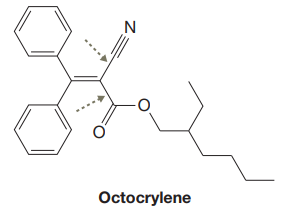
The above molecule has two benzene rings. Each carbon atom in the benzene ring has three electron groups: two single bonds and one double bond. Thus, the geometry for all these carbon atoms must be trigonal planar and hybridization must be

The triple bonded carbon atom has two electron groups: one single bond and one triple bond. Thus, the hybridization of this carbon atom must be

The single bonded oxygen atom and each carbon atom in the alkyl chain has four electrons groups. Thus, its geometry must be tetrahedral and hybridization must be

Hybridization of all non-hydrogen atoms is shown in three figures as above.
(b)
Interpretation:
All the atoms bonded to the acyclic
Concept introduction:
Free rotation can occur about single bonds but not about double bonds. According to the VSEPR theory, if an atom has three electron groups: three bonds, or two bonds and one pair of electrons then, the atom is said to be
Answer to Problem 3.54P
Explanation of Solution
The given structure for Octocrylene is:
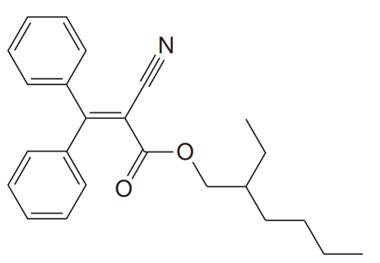
In the above structure, the
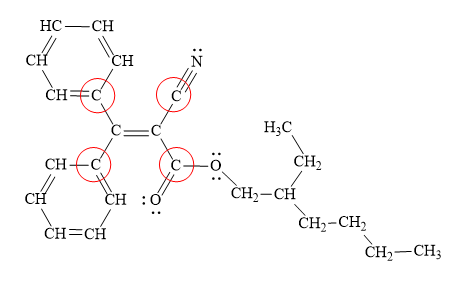
All the atoms bonded to the acyclic
(c)
Interpretation:
It is to be determined if there are two unique configurations possible about the acyclic
Concept introduction:
No free rotation takes place about the double bonds. Hence, in such compounds, molecules that differ by the exchange of two groups on one of the doubly bonded atoms are said to have different configurations. It is a cis configuration if the two non-hydrogen substituents are on present the same side of the double bond, and it is trans if they are on the opposite sides.
Answer to Problem 3.54P
It is not possible to have two unique configurations about the acyclic
Explanation of Solution
The given structure for Octocrylene is:
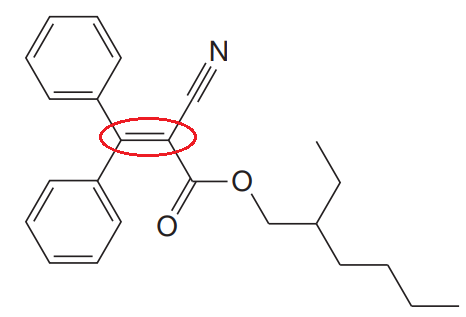
In the structure above, the acyclic
Thus, it is not possible to have two unique configurations about the acyclic
For a
(d)
Interpretation:
Out of the two indicated
Concept introduction:
The bond distance decrease and bond energies increase as the hybridization of the atom goes changes
Answer to Problem 3.54P
The
Explanation of Solution
The given structure for Octocrylene is:
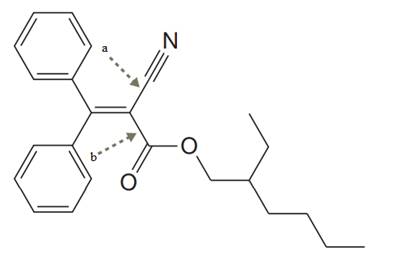
In the structure above, the two
The two carbon atoms involved in ‘a’ type of are
The two carbon atoms involved in ‘b’ type of bond are both
The bond distance decrease and bond energies increase as the hybridization of the atom goes changes
Want to see more full solutions like this?
Chapter 3 Solutions
Organic Chemistry: Principles and Mechanisms (Second Edition)
- Predict the product of this organic reaction: IZ + HO i P+H₂O Specifically, in the drawing area below draw the skeletal ("line") structure of P. If there is no reasonable possibility for P, check the No answer box under the drawing area. No Answer Click and drag to start drawing a structure. ☐ :arrow_forwardPredict the products of this organic reaction: 0 O ----- A + KOH ? CH3-CH2-C-O-CH2-C-CH3 Specifically, in the drawing area below draw the condensed structure of the product, or products, of this reaction. (If there's more than one product, draw them in any arrangement you like, so long as they aren't touching.) If there aren't any products because this reaction won't happen, check the No reaction box under the drawing area. No reaction Click anywhere to draw the first atom of your structure. X ⑤ èarrow_forwardPredict the products of this organic reaction: O CH3 + H2O + HCI A A? CH3-CH2-C-N-CH3 Specifically, in the drawing area below draw the condensed structure of the product, or products, of this reaction. If there's more than one product, draw them in any arrangement you like, so long as they aren't touching. If there aren't any products because this reaction won't happen, check the No reaction box under the drawing area. No Reaction Click anywhere to draw the first atom of your structure.arrow_forward
- What is the missing reactant in this organic reaction? R+ HO-C-CH2-CH3 0= CH3 CH3 —CH, C−NH—CH CH3 + H₂O Specifically, in the drawing area below draw the condensed structure of R. If there is more than one reasonable answer, you can draw any one of them. If there is no reasonable answer, check the No answer box under the drawing area. Note for advanced students: you may assume no products other than those shown above are formed. No Answer Click anywhere to draw the first atom of your structure. €arrow_forward个 CHEM&131 9267 - $25 - Intro to Mail - Hutchison, Allison (Student x Aktiv Learnin https://app.aktiv.com Draw the product of the reaction shown below. Ignore inorganic byproducts. + Na2Cr2O7 Acetone, H2SO4 Type here to search Dryng OH W Prarrow_forwardPredict the products of this organic reaction: OH + NaOH A? Specifically, in the drawing area below draw the skeletal ("line") structure of the product, or products, of this reaction. (If there's more than one product, draw them in any arrangement you like, so long as they aren't touching.) If there aren't any products because this reaction won't happen, check the No reaction box under the drawing area. No reaction Click and drag to start drawing a structure. ✓ Sarrow_forward
- Predict the products of this organic reaction: CH3-C-O-CH2-CH2-C-CH3 + H₂O ? A Specifically, in the drawing area below draw the condensed structure of the product, or products, of this reaction. (If there's more than one product, draw them in any arrangement you like, so long as they aren't touching.) If there aren't any products because this reaction won't happen, check the No reaction box under the drawing area. No reaction Click anywhere to draw the first atom of your structure. :☐ darrow_forwardDE d. Draw an arrow pushing mechanism for the following IN O CI N fo 人 P Polle DELL prt sc home end ins F5 F6 F7 F8 F9 F10 F11 F12arrow_forwardPredict the products of this organic reaction: + H₂O H* ? A Specifically, in the drawing area below draw the skeletal ("line") structure of the product, or products, of this reaction. (If there's more than one product, draw them in any arrangement you like, so long as they aren't touching.) If there aren't any products because this reaction won't happen, check the No reaction box under the drawing area. No Reaction Click and drag to start drawing a structure.arrow_forward
- Predict the major organic products of the reaction below and draw them on right side of the arrow. If there will be no significant reaction, check the box below the drawing area instead. C Cl CH, OH There will be no significant reaction. + pyridine G Click and drag to start drawing a structure.arrow_forwardWhat is the missing reactant in this organic reaction? H R+ H2O Δ OH 0= CH3-CH-O-CH3 + CH3-C-OH Specifically, in the drawing area below draw the condensed structure of R. If there is more than one reasonable answer, you can draw any one of them. If there is no reasonable answer, check the No answer box under the drawing area. No Answer Click anywhere to draw the first atom of your structure. dyarrow_forwardYou are trying to determine whether the following organic reaction can be done in a single synthesis step. If so, add any missing reagents or conditions in the drawing area below. If it isn't possible to do this reaction in a single synthesis step, check the box below the drawing area instead. Note for advanced students: if you have a choice of reagents to add, you should choose the least reactive and most economical reagents possible. Cl It isn't possible to do this reaction in a single synthesis step. + T OHarrow_forward
 Chemistry: Principles and PracticeChemistryISBN:9780534420123Author:Daniel L. Reger, Scott R. Goode, David W. Ball, Edward MercerPublisher:Cengage Learning
Chemistry: Principles and PracticeChemistryISBN:9780534420123Author:Daniel L. Reger, Scott R. Goode, David W. Ball, Edward MercerPublisher:Cengage Learning Chemistry: The Molecular ScienceChemistryISBN:9781285199047Author:John W. Moore, Conrad L. StanitskiPublisher:Cengage Learning
Chemistry: The Molecular ScienceChemistryISBN:9781285199047Author:John W. Moore, Conrad L. StanitskiPublisher:Cengage Learning

